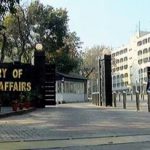By Dr Saeed Ahmed Ali
LAHORE, Nov 03 (APP):Every year, with the arrival of winter season, chemical smoke after mixing with fog, forming a thick cloak of smog, hovering over the roads, particularly during dawn and dusk, causing threat to public health and road users due to toxic gases and hindering visibility.
Smog, which routinely engulfs Lahore and several other cities of the country from November to December, also disrupts airflow and traffic movement on the roads. Resultantly, the economic damage and disruptions in transport logistics causes huge loss to national exchequer.
According to World Health Organization (WHO) report in 2015, approximately 60,000 Pakistanis died of higher levels of toxic, Particulate Matter (PM2.5), which was directly associated with environmental disorders.
The WHO in its report had further revealed that during foggy season, levels of dangerous Particulates Matter (PM2.5), are enough to penetrate deep into lungs and enter into bloodstream, which damages human health by reaching 1,077 micrograms per cubic meter, (more than 30 times what international health experts consider the safe limit).
Talking to APP, Dr Tehsin Riaz, a noted physician said smog causes itchy-eyes and sore-throat. He said there was clear evidence that polluted air causes depression and Alzheimer’s disease, an irreversible brain disorder that slowly destroys memory and thinking skills and harms the ability to carry out the daily routine tasks.
The Space and Upper Atmosphere Research Commission (SUPARCO) in its recent report said Pakistan Meteorological Department (PMD) stations did not provide sufficient information during the smog season, adding, they could only provide reading of fog-points’ measurement, and its observations.
Suggesting remedy, the report said continuous monitoring and spatially coherent picture of smog distribution was possible through the use of satellite observations.
A senior official in SUPARCO said space study reports and satellite data of atmospheric pollutants were being used across the globe to overcome smog issues by making decisions in environmental management activities.
Misbah-ul-Haq Khan Lodhi, Director Punjab Environmental Protection Department said Punjab Government ahead of November, had decided to close conventional kilns in consultation with the Smog Commission, which had been tasked to identify the root causes of fog generation, and to formulate a policy by prescribing a plan to protect people’s health.
The International Centre for Integrated Mountain Development (ICIMOD) scientists’ study report conducted during 2014-2015, had revealed that mass concentration of PM10 at all sampling sites within Lahore city exceeded the National Environmental Quality Standards (NEQS) levels during the reading periods.
The objective of this study was to determine the spatial distribution of aerosols, their types, and to identify the aerosol origins during special weather conditions like smog in Pakistan.
Punjab Provincial Minister for Environment Protection, Bao Muhammad Rizwan said Punjab government has taken several emergency measures to counter smog, including a strict ban on burning crops and solid waste.
He said last year more than 100 people were arrested for crop burning and during the current year hundreds of factories have been shut down for not having proper emission-control equipments.
The officials of Lahore Traffic Police department said they have collected more than US $ 50,000 in fine in recent days from drivers whose vehicles did not meet emissions standards, adding, Punjab government have set up two centres for checking commercial vehicles for compliance of environmental rules.
Noted environmentalists said, “We have urged Punjab government to take real solution and concrete measures to improve fuel quality, introduce solar and other renewable energy resources, phase out fuel-guzzling vehicles, devise policy for massive tree plantation and improve public transportation to reduce the number of vehicles on the much busy roads.”
Although smoke from crop burning in India is a major reason of smog, but they should formulate their own mechanism to reduce this crisis, environmentalist Mehmood Khalid Qamar said.
On the request of the Punjab government, Food and Agriculture Organization (FAO) of United Nations under its project R-SMOG (Remote Sensing for Spatio-Temporal Mapping of Smog) has prepared a report on smog for the country.
According to the FAO report, contribution of agriculture sector in smog generation, through crops residue burning, was the third sector of air pollutant emissions.
The report calculated percentage shares of different sectors in generating smog which contribute 45 percent of transport sector, 27 percent of industrial sector and almost 20 percent from agriculture.
Satellite data of atmospheric pollutants were being widely used globally in the decision-making and environmental management activities of public, private sector and non-profit organizations, it further said.
Following the FAO report, the Punjab government has taken up policy and decision making, and recommended the establishment of smog monitoring and early-warning systems.
The Punjab government has started adopting the recommendations of FAO report, which needed to support farmers for adopting mechanized farming and climate smart practices to avoid losses due to smog which also increases crop yields.







